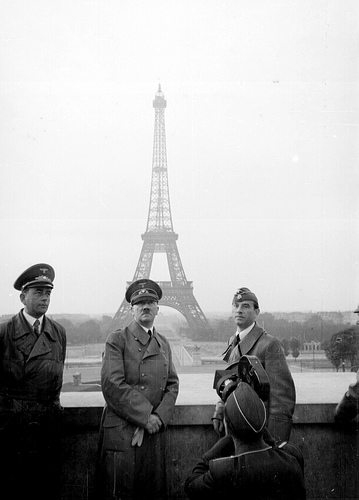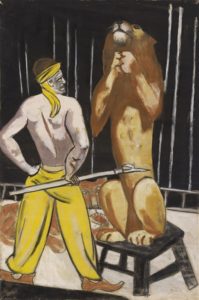On 5 March 1933, Germany held a Federal election. The NSDAP and its storm troopers waged a violent war against its electoral opponents before the election. However, when the votes were counted, Hitler and the Nazis only achieved 43.9% of the vote, giving Hitler 288 seats in the 647 seat Reichstag, well short of the 324 required for a majority, although as the leader of the largest party and of the coalition government Hitler became Chancellor. The election was to be the last held in Germany before Second World War, as Hitler and the Nazis quickly intimidated the other members of the Reichstag into passing the Enabling Act, that gave Hitler dictatorial powers, before ultimately driving the other parties out of the Reichstag and then dissolving it, making Germany a one-party state. When President Hindenburg died in early August 1934, Hitler declared the office of President permanently vacant, effectively merging it with the office of Chancellor, and making him the Head of State, the Head of Government and the Head of the Army. Hitler’s rise to power is, of course, infinitely more detailed and complex than this short summary, however for present purposes the significant fact is that by mid-1934 Hitler and the Nazis were in complete control of Germany.
Hitler’s anti-Semitism was apparent well before he came to power, and following the election in 1933, attacks and economic pressure on the Jewish community, their businesses and synagogues intensified. On 1 April 1933, Hitler announced a national boycott of Jewish businesses, and on 7 April, laws were passed forcing all non-Aryans out of the legal profession and the civil service, a ban that was ultimately extended to all government-regulated professions such as medicine, teaching and journalism. The segregation of the Jewish community continued with a raft of other race-based laws and restrictions, including a ban on Jewish ownership of farmland, the passage of the Nuremberg Laws in September 1935, which among other things forbade relationships and marriage between Jews and Germans, and culminating in the 1938 Regulation for the Elimination of Jews from the Economic Life of Germany, that effectively stripped Jews of all property rights, and Kristallnacht.


As the Nazi pressure on the Jewish community in Germany steadily grew, many Jews saw that they had no future in Germany and they began to shift money and assets out of Germany, in some cases into bank accounts in Switzerland, and flee. Eventually laws were passed in Germany that made it an offence to hold assets in foreign banks, and the Gestapo monitored trains and travel to places such as Switzerland to catch people illegally seeking to move money into foreign accounts. Immediately prior to the outbreak of the war, Jews fleeing Germany were required to pay a tax equal to the value of 90% of their assessed assets, and in seeking to pay the tax to escape Germany, or simply hide their wealth, many sold property and possessions at prices that reflected the duress under which it was sold.
None of this went unnoticed in Switzerland, which in 1934 was formulating new banking laws and also coming under pressure from Germany to release information on Jewish people who held accounts in Swiss banks. At the same time France was also pushing Switzerland for information on undeclared accounts held by certain politicians, judges and church leaders.
Swiss banks practised a code of secrecy as far back as the 18th century, and have long provided a safe haven for the funds of people fleeing persecution in one place and form or another; for example, the Swiss banks provided a safe haven for the funds of many a nobleman fleeing the French Revolution. The early regulations date back to 1713 when the Great Council of Geneva required banks to keep a register of their clients but also prohibited the information being divulged without the consent of the client or the permission of the Great Council. Breaches of the code of secrecy were a civil matter, and a client whose confidentiality had been violated could sue for civil damages. By 1934, as Germany clamped down on the Jewish community and their attempts to move assets away from Germany, the draft the new Federal Act on Banks and Savings Banks was amended to, for the first time, make it a criminal offence for a Swiss bank to release the name of an account holder. The system of confidentiality evolved over time to include accounts that have only a number, although more recently the system of confidentiality has been watered down by amendments to the law and international treaties that permit disclosure.
If you don’t believe that everything old is eventually new again, then consider this. Germany today is no fonder of its citizens holding money in foreign accounts than it was during the Nazi era, although ostensibly for different reasons, now said to be tax evasion in the cash economy. Today, as in the 1930s and 1940s, German customs officers monitor the trains travelling between Switzerland and Germany hoping to catch people, among other things, taking cash into or out of the country. And so it was that in late 2010, Bavarian customs officers boarded a train from Zurich to Munich for a routine check and questioned an old and frail man about the purpose of journey. He was travelling on an Austrian passport and he said that he lived in Munich. The purpose of his trip was he said to visit an art gallery in Bern, but he seemed agitated. Suspicions aroused, the customs officers searched him and they found an envelope containing 9,000 Euros in cash, which is not of itself illegal, and he was permitted to continue on his way. The circumstances were, however, reported and subsequent enquiries revealed almost nothing about him in Germany other than that he lived in a very expensive apartment that he owned in Munich, and that he paid taxes in Austria as his place of residence. His name was Rolf Gurlitt, although he went by his third Christian name, Cornelius.
It could easily have been left at that except, in one of those strange twists of fate, a German officer enraged in Raubkunst, finding and recovering art looted by the Nazis, their interest aroused by the name, the cash and the explanation of visiting an art gallery, wondered whether the man was connected to the notorious Hildebrand Gurlitt.


Hildebrand Gurlitt was a second-degree Mischling according the Nazi racial purity laws, meaning that he was one-quarter Jewish, although in circumstances that are not fully known, he became an approved art dealer during the reign of the Nazis. As Jews desperately sold possessions, including art that today is regarded as masterpieces, they faced many restrictions, including that the art could only be sold to a Nazi-approved art dealer and, as one, Hildebrand Gurlitt amassed a large cache of incredibly valuable art. After the war began, and Germany swept through and then occupied the lowlands, France and other countries, Jews in those countries were subjected to Nazi racial policies and again many sold, hid or abandoned valuable possessions including art, and there was no shortage of people willing to take advantage of them.
In France the art dealer named Alan Delon bought art from fleeing Jews and then sold it at auction; and Hildebrand Gurlitt attended the auctions and bought many works. He apparently attended other auction sales of distressed art and possessions. It has also been suggested that Hildebrand Gurlitt knew the names of many wealthy Jewish collectors in France and other occupied countries and that he went to their abandoned homes and simply took their most valuable works. Later Hildebrand Gurlitt worked with Goebbels to find works for the museums planned by Hitler and in the process had access to the shipments of art looted by Germany from the occupied territories that is now called the ‘greatest art theft in history’. There is no precise number, and perhaps we will never know, but it estimated that the Germans stole 650,000 works in total and that nearly 100,000 were taken from Jews in France.
So what began as a suspicion of tax evasion by Cornelius Gurlitt was becoming something rather different, but there was no evidence that he had or was selling looted art. Further enquiries revealed rumours that Cornelius Gurlitt had a large collection of art and eventually a warrant was obtained to search the apartment in Munich, although for reasons that have never been adequately explained, the warrant was not immediately executed. Eventually, in late 2011, the German authorities received information that Gurlitt had recently sold a painting by Max Beckman titled The Lion Tamer, and most significantly that in doing so he had split the proceeds with the heirs of a Jewish art dealer named Flechtheim, who fled in 1933 abandoning his collection, which included The Lion Tamer.
The search warrant was executed and inside Gurlitt’s Munich apartment the authorities found 1,406 works by an astonishing array of masters, including Picasso, Matisse, Renoir, and Chagall, to name but a few. Estimates of the value are necessarily imprecise but could easily exceed one billion US dollars. The works were seized and are in the custody of the German government while attempts are made to unravel the historical, legal, moral and ethical Gordian knot to resolve the true title to the works under current German law.

Germany has extensive laws to deal with claims for restitution of property taken during the Nazi reign, but the question is far more complex. While the works are today in Germany, many were taken in other countries that have their own laws, and there are competing claims as to jurisdiction and present ownership. In some cases the provenance of the works are quite simply not now, and may never be, known. Cornelius Gurlitt died in 2012, without known family or heirs, and at the date of his death he was not charged or convicted of any crime. Although the fact that he settled a claim relating to The Lion Tamer, and kept his collection so secret, are some indirect evidence that he knew that the provenance and title to at least some of the collection were badly stained. There are currently 91 other works among the seized collection suspected of being bought under duress or looted.
In 1938, Elsa Helen Cohen was fleeing Nazi Germany and, to fund her escape, she sold to Hildebrand Gurlitt a drawing of the interior of a Gothic Church by Adolph Menzel. The drawing was among the works found in Cornelius Gurlitt’s apartment and it has recently been returned to her heirs.
A painting by Pissarro, The Seine from the Pont-Neuf, was also found in the apartment and has recently been returned to the heirs of its French-Jewish owner, Max Heilbronn, who was an owner of a store in Paris today known as Galaries Lafayette.
Whether he deserves the fate or not, Cornelius Gurlitt will be remembered only as an accessory to some of the greatest crimes known in modern times, and Hildebrand Gurlitt will inevitably be remembered as the worst kind of profiteer from the suffering of Jews in Europe during the Nazi reign and occupation. Although nothing is ever quite so black and white; could Elsa Cohen have escaped Germany, and the fate of many German Jews, if Gurlitt had not bought the Menzel from her? Would Hildebrand Gurlitt claim that he was helping the persecuted to escape, and saving priceless works of art in the process? Unpalatable as it may be to recognise, it is probably true to say that many people, and works of art, probably survived the war because Gurlitt bought them, although his other actions, including the failure after the war to reveal or repatriate the works, suggest that he had no proper underlying motive. Although the final chapters of this story are far from written, the historical fate of both men is forever sealed.
Germany says that it has an absolute obligation to find the rightful owners of all of the works, and to return them. What they will do with the works for whom there is no provenance remains to be seen; hopefully they will go on public display to educate future generations about the true face and consequences of totalitarian regimes – it might help them to better recognise the threat when and if they see it, and stop them unfairly applying the epitaph to others.
The return of the works to heirs of Elsa Cohen and Max Heilbronn are the far too late righting of a terrible wrong, and a small reminder that for all of the things that seem to be so badly awry today, there is still some good to be done and some positive news to be found.










